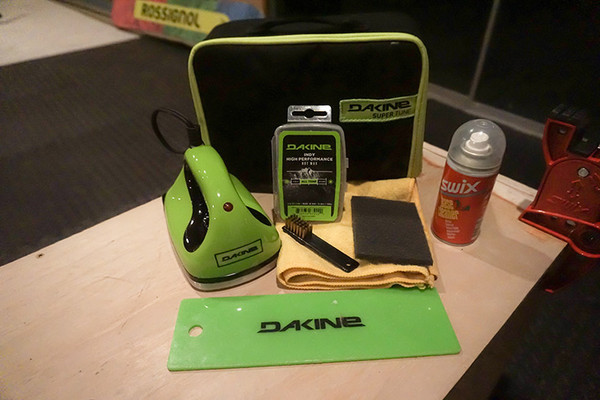Make It Last: How to Wax Skis and Snowboards
Posted by Garson Fields on 9th Dec 2020
Make it Last is dedicated to getting the most out of your gear. This is our place to share knowledge acquired over years of abusing outdoor equipment, so you can learn from our experience and our mistakes. We want you to use your gear, patch it up until you can’t anymore, and enjoy it to the fullest. And when you finally need a new piece, we can help you with that too.
Waxing is something that every skier and snowboarder should know how to do. Not only is it critical to keeping your skis or snowboard working as intended, the tools and know-how will also quickly pay for themselves.
Unless you're racing, you’re really just looking for consistent glide in all conditions. It’s a simple goal, which likewise makes the process straightforward.
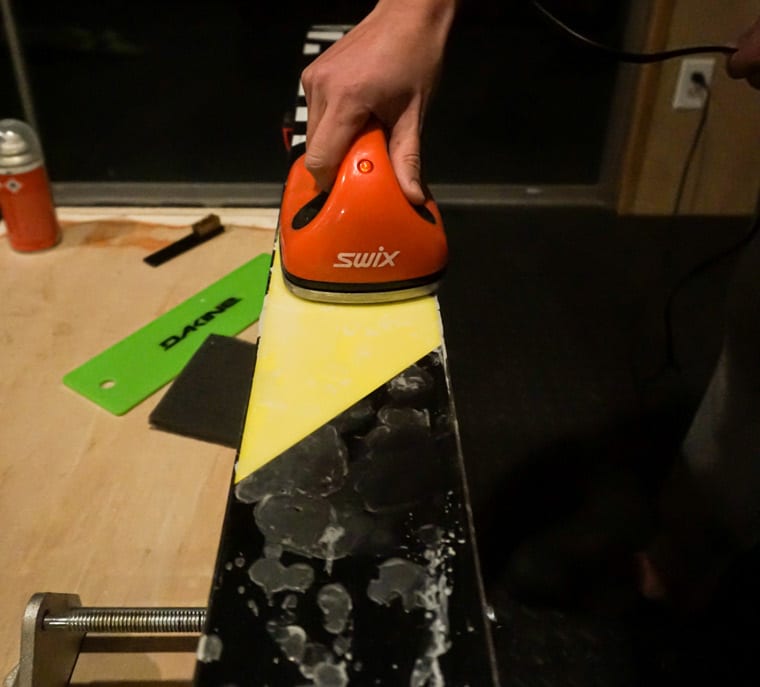
While waxing isn’t difficult, it does require knowledge, time, and a few essential items. This guide is here to help with the knowledge bit. It's laid out in the following order:
- When to Wax Your Skis or Snowboard
- Choosing the Right Ski Wax
- Supplies You’ll Need
- Waxing Procedure
- When to use Rub-On Wax
Read on to get the scoop, plus a race-proven wax saving secret that you probably haven’t seen before.
When to Wax
You can’t wax too often. Other than the time it takes and the cost of wax, there’s no downside. In an ideal world, you’d wax before every day you head to the hill.
However, in the real world, we all have limited time to devote to tuning. At a bare minimum, you’ll want to wax before the season starts, at the end of the season before you put your gear into storage, and throughout the season when your base starts to get dry. You’ll also want to wax brand new skis and snowboards, even if they’re waxed from the factory.
Going too long in between wax jobs will damage your base, especially on dry snow. This is known as base burn, and it adds drag and compromises the ability of your base to absorb wax. Once base burn has set in, you’ll need to get a base grind from your local ski shop to restore your gear.
You’ll know that your base is getting dry when the surface starts to look white or ashen. You’ll notice this occurs next to the edges before the center is affected, especially on snowboards.
Choosing the Right Wax for Your Skis or Snowboard
There are tons of options, but if you’re new to tuning, there’s no need to overthink it. Just pick a quality all-temperature wax and stick with it.
There are waxes optimized for very cold and dry snow, but non-racers will gain little appreciable benefit over a quality all temp wax. On the other hand, if it’s warm and the snow has a high moisture content (i.e. spring slush), applying warm temp wax will give you slightly better glide. If you're picky, you'll notice a difference.
It’s also important to note that the ranges on ski waxes cover snow temperature, not air temperature.
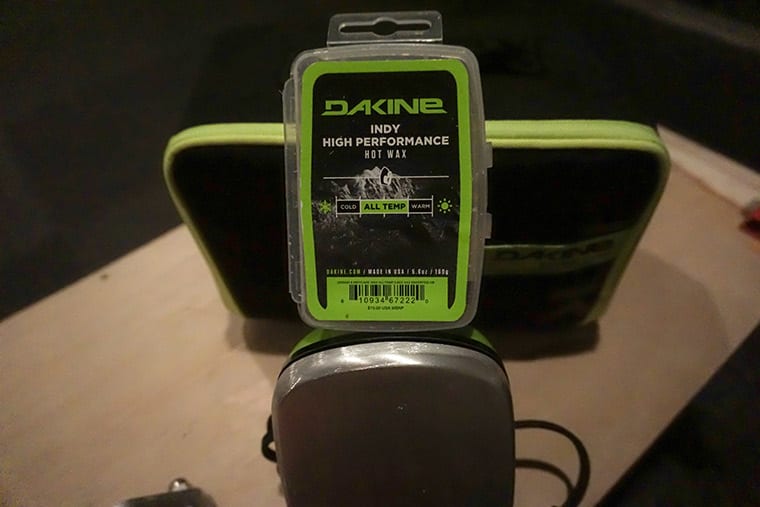
However, unless you want to devote your energy to matching your wax to the weather forecast, pick a quality all temp option and focus on waxing regularly.
For a cost-effective option we like Dakine Nitrous All Temp, but plenty of brands, including ski racing staples like Swix and Toko, or snowboard stalwart Oneball Jay, offer worthy options.
Fluorinated vs. Non-Fluorinated Wax
You may have come across fluorinated waxes, which are typically identifiable by the much higher price tags they command. We’re going to recommend that you skip them altogether. The addition of fluorocarbons almost always means they’re rich in toxic PFOAs, which will end up accumulating in the water supply. That’s why they’re on their way out, even for racers.
Fluorinated waxes are a little bit faster than traditional hydrocarbon waxes, so they’ve traditionally been considered “race grade.” However, the FIS, ski racing’s global governing body, is currently in the process of banning them at every level of competition. If you want to know more about the ban, check out this article from skiracing.com.
What You Need for Waxing
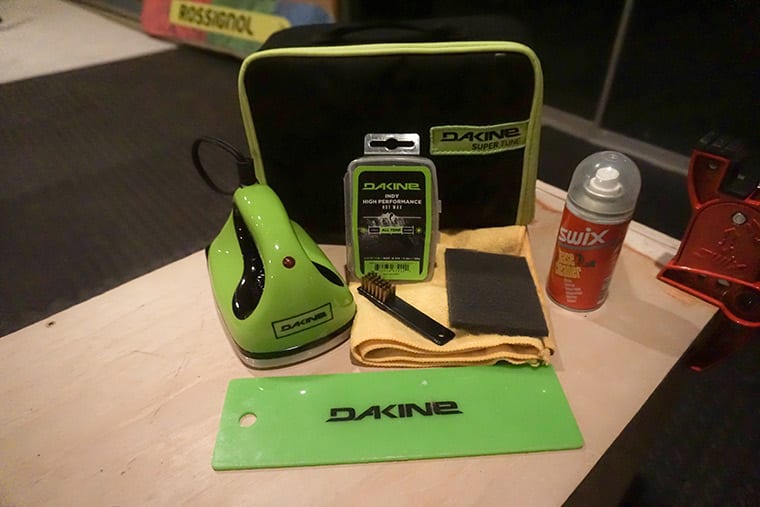
Time: Budget 45 uninterrupted minutes if you’ve never waxed before. That should be plenty of time to set up your workspace, do the work, and clean up. Once you get the process dialed, it can be handled much more quickly.
Workspace: Although plenty of people like to have a dedicated tuning bench, there’s no need to set up a permanent waxing spot. What you’ll need is enough room to work and a power source for your iron. It’s also a good idea to put down an oversized piece of cardboard, some newspaper, or an old carpet under your workspace. Hot wax drips and shavings can make a mess, so prepare your workspace accordingly.
A Stable Rest: Whether you use a dedicated tuning vice, two sawhorses, or a couple of old textbooks stacked on a table, you’ll want something that your skis or snowboard will rest on solidly when you place them upside down.
Wax: Any quality all-temperature wax will do.
Base Cleaner: A quality citrus base cleaner is key to getting good results on a dirty base. You won’t need to use it often, but it’s an essential part of a complete tuning kit.
Iron: Use a dedicated ski and snowboard waxing iron. If it’s adjustable (plenty of quality irons are not), set it to the heat range recommended on the package for your wax of choice.
Yes, you can get away with using a clothes iron. No, that doesn’t mean that you should.
Scraper: Use a wide plastic scraper. Metal scrapers are for repairing base damage, not scraping wax.
Ski Straps: If you’re tuning skis, you’ll want a pair of ski straps to hold the brakes in the “up” position to keep them out of the way of your iron. Rubber bands will also do the job.
Brush: Although it can be hard to tell at a glance, your base may not actually be a flat surface. Higher-end equipment with sintered bases will usually have a structured base. Unless you’re riding entry-level or park-focused gear with an extruded base, you’ll get the best results if you brush your base after scraping.
If you only have one brush, get one with either nylon bristles, or a mix of nylon and brass bristles. If you have multiple brushes, start with your stiffest, coarsest brush and work your way to your finest brush when finishing your bases.
You can also use a scouring pad for cleaning dishes to buff your base. If you go this route, make sure your pad is 100% synthetic, not metal, and it isn’t pretreated with soap.
How To Wax Your Skis or Snowboard
Prep Your Workspace
Start by setting up whatever rest you’ll be using, covering anything you don’t want to get wax on, and laying out everything you’ll be using.

Prep Your Skis or Board
If you’re going to sharpen your edges, do it before waxing. Also, if your edges have any burrs or damage, use a hand file to smooth out the affected area. Burrs can scratch your iron, and a scratched iron will scratch your base material.
For skis, hook a ski strap over the top of the heel piece of the binding to pull the brakes into the “up” position.

For snowboards, some tuners advocate removing your bindings, or at least loosening your binding screws. Doing so relieves tension on the inserts, which can cause low spots in the base that makes waxing and scraping more difficult. Additionally, the screws act as heat sinks and will hold heat in the board.
Realistically, it doesn't make any difference, but the option is there if you're a perfectionist.
Clean
For routine waxing, there’s no need to do anything other than wipe down your base with a dry, lint-free rag before getting to work.
If your base is visibly dirty, has been feeling slow even after waxing, or you’ll be applying a different wax than you last used, you’ll want to do a deep clean.
Start with a citrus base cleaner. Apply a bit to a rag and wipe down your base(s), working over every square inch. Give it a few minutes to air out.
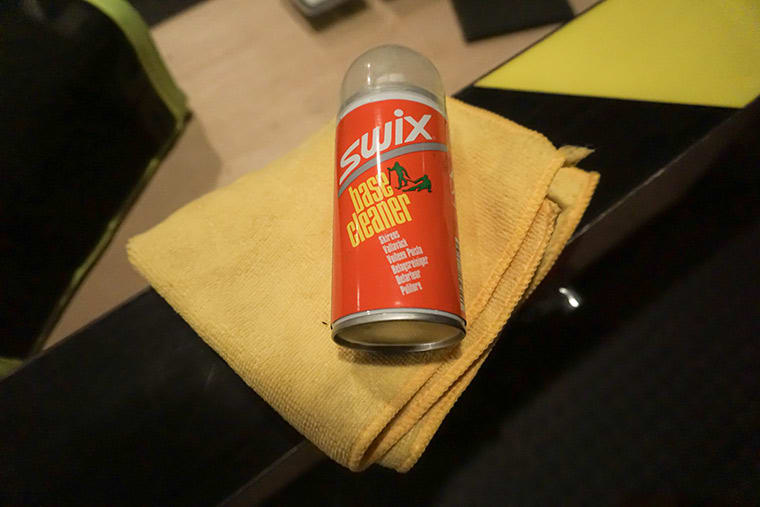
After cleaning with citrus base cleaner, you’ll want to wax your base and immediately scrape it while the base is still warm. This will pull the last of the contaminants out of the base. Afterwards, you’ll want to wax again as described below.
Waxing
Let your iron warm up for a few minutes. That’s important to let the temperature of the iron stabilize before you get to work.
You're probably familiar with the “drip” method of applying wax, where you place the iron onto the bar of ski or snowboard wax and let it drip onto your plank(s). It's a time tested approach, but it’s generally pretty wasteful.
Instead, try a method that many World Cup ski technicians use to conserve wax. Quickly touch the wax bar to the iron, then rub that freshly warmed portion of the wax onto your base. Repeat until the entire base is covered.
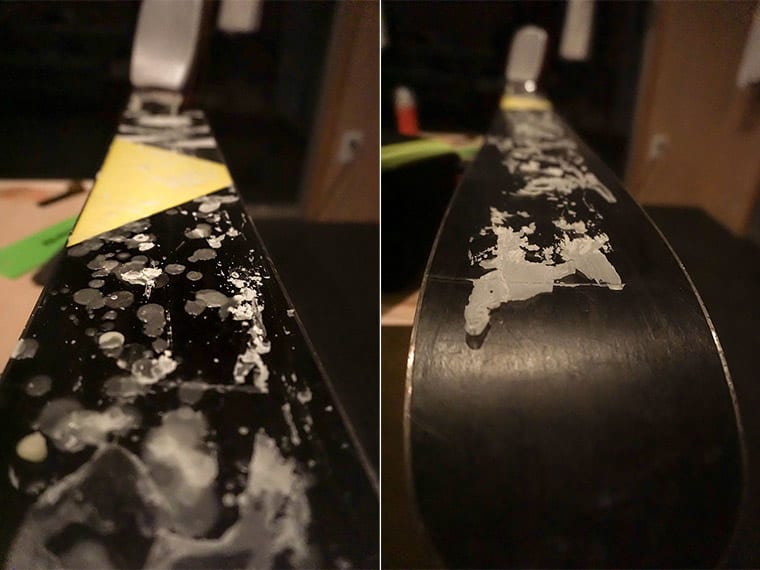
This covers the base in a thinner layer of wax, which means there’s less excess to scrape off.
Once the base is covered, work the iron across the base, covering the entire surface. You’re looking to do it at a pace that leaves a 3-4” trail of visibly melted wax in its wake. If you go faster, you won’t properly heat the base material, which opens the pores in the base and pulls in wax. If you go slower, or worse, let the iron sit, you risk melting the base material and damaging the adhesives that hold your skis or board together.
If at any point, the wax starts to smoke, your iron is too hot and should be turned to a lower heat setting, if possible.
When you’re done, check over the base and make sure that you haven’t missed any spots.
Let your gear sit until it’s completely cooled off. 10 minutes should be plenty.
Scraping
Push your plastic scraper away from you, working from the tip to the tail. The goal is to apply even pressure. You’ll want to make more than one pass to ensure you’ve removed as much extra wax as possible.
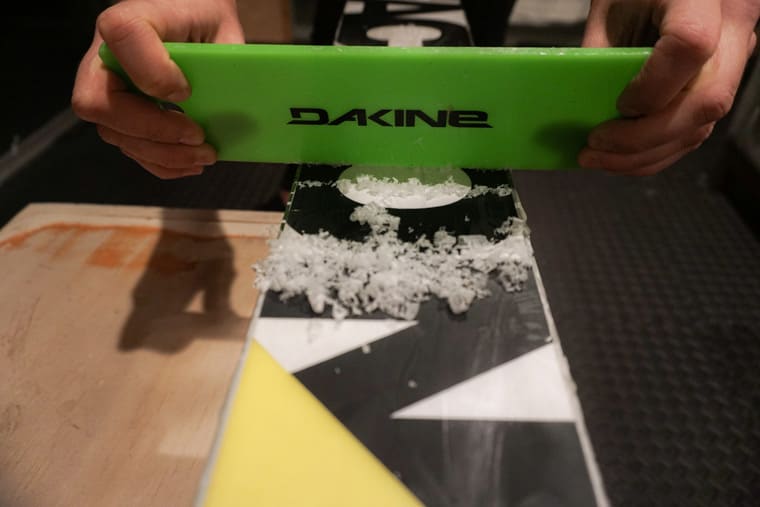
Brushing/Buffing
After scraping, if you have a sintered base and you want to get the full effect of your fresh wax job, you’ll want to brush or buff.

The goal is to remove the excess wax that scraping leaves behind. It works by clearing out the structure, allowing it to channel water from under your base, which breaks surface tension for maximum glide.
Regardless of whether you’re using brushes or a scouring pad, the process is the same. Starting at the tip, apply even pressure and push the tool in question towards the tail. You’ll want to repeat the process a few times. Keep going until you’re no longer removing fine flecks of wax.
When to Use Rub On or Spray Wax
No matter what anyone tells you, rub on wax isn’t a substitute for hot wax. Rather, it’s a supplement to a good hot wax.
While hot wax is absorbed into base material, rub on and spray wax are designed to sit at the surface. It’s extremely slippery which makes it great for a quick hit of speed. However, you shouldn’t expect it to last more than a run or two before it wears off completely.
Nevertheless, there’s a good reason that an average skier or snowboarder would want to keep a tin of rub on wax in their gear bag, and that’s spring conditions.
When the snow is slushy, the surface tension between the snow and your skis or board can cause serious stiction. Especially if you’re running all temp wax, applying rub-on wax every few runs is a highly effective way to preserve your glide when the conditions call for short sleeves and sunscreen.
In Closing
Once you get used to sliding on a freshly tuned setup, you’ll find that dry bases are a drag. And since an entire waxing setup, like the Dakine Super Tune Tuning Kit, can be had for less than the price of a one-day lift ticket at many resorts, there’s really no excuse for paying a shop to do your waxing for you.
It doesn’t take long to hone the process. Do it a few times to commit it to memory. Every time you drop in on a freshly tuned setup, you’ll be glad you made it a part of your practice.
About Campman
Campman is an outdoor retail store located in Salt Lake City, Utah, that specializes in gear and equipment for camping, skiing, backpacking, climbing, and everything in between. We understand that the difference between a bad memory and the adventure of a lifetime can come down to the gear you take with you when you head outdoors, and we want our customers to have the best experiences possible. When it comes to getting outside, we get it, and we’ll get you the gear you need to get there.
Questions? Feel free to contact us by phone at (801) 999-8117 or by email at sales@campman.com.
Share on:

